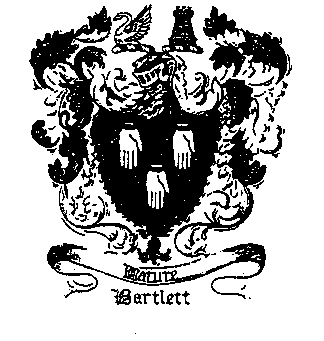
Bartlett
Family
All persons in this country, named Bartlett, are without doubt of Norman ancestry. There is a large estate at Stopham, Sussex, England, consisting of some thousands of acres, which has been in possession of the Bartletts for hundreds of years. From junior members of this family in former times, came the first settlers on these American shores. The Ancestral Mansion was built in 1309, and is a noble building of stone. Near it, stands the old Norman Church, built by the family in the Thirteenth century, and on the stone floor, along the aisles of the church, are marble slabs with inset figures of brass, showing a regular succession of Bartletts, from John, who died in 1428, to Colonel George Bartlett, or Barttelot, as the name was spelled in early times, who died in November, 1872, aged 84 years. Here have the Bartletts lived since the time of the Norman invasion. The first of the family was Adam Barttelot, an esquire in the retinue of Brian, a Knight, and they came into England with William, the Conqueror, and fought at Hastings. Both were granted lands. In the Fifteenth century, a castle appears as the crest of the coat of arms which was granted by Edward, the Black Prince, to John Barttelot, for taking the castle of Fontenoy, in France. In the Sixteenth century, a swan was added, and granted, by the Garter King of Arms. Since that time, the crest is double a castle, and swan. The original coat of arms of the family was three open, left-hand, falconer's gloves, with golden tassels about the wrist. The coat of arms now in use is very elaborate, representing different coats of arms of families who have inter-married with the Barttelots. The quarterings of Smith, Musgrave and Boldero,
were added in 1875, when Sir Walter B. Barttelot, the present representative of the family, was created a baronet.
The family lineage with the succession from the Norman ancestor to the present time, may be found in Sir Bernard Burke's "Genealogical and Heraldic Dictionary of the Peerage and Baronetage," which in England is the authoritative book of titular genealogical reference; almost every public library in this country has a copy amongst its standard works of reference.
The name is spelt in many different ways in the family record, B-a-r-t-t-e-l-o-t occuring most frequently in the older documents. At the present time--with few exceptions--the spelling is B-a-r-t-l-e-t-t. It appears that, in former times, many of the younger members of the family, who were obliged to seek their fortunes elsewhere on the accession of their elder brother to the entailed inheritance, adopted a different spelling of the name. It is quite evident that this change in spelling was not, originally, wholly the result of captrice or accident. The intention may have been that it should be designative, to denote the diminutive, or lesser, of the Barttelots. Sir Walter, like most of his predecessors who were incumbents of the ancestral estate, uses the ancient Norman orthography.
The origin of the name does not appear to be known. Its existence at such a remote period would seem to prevent any intelligent supposition as to the way it first originated. The derivation from Bartholomew, as presented by a writer on surnames, appears labored and "far-fetched," and without corroborative reference, will fail to satisfy the enquirer.